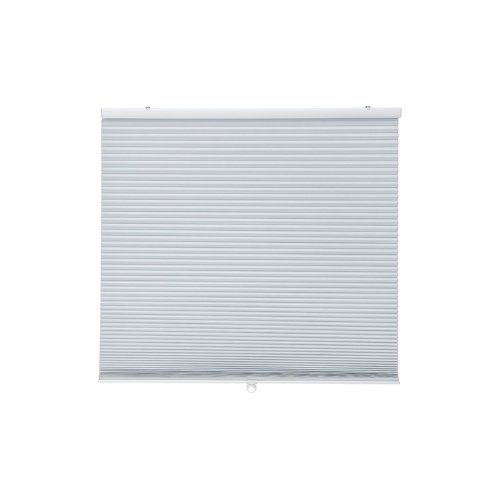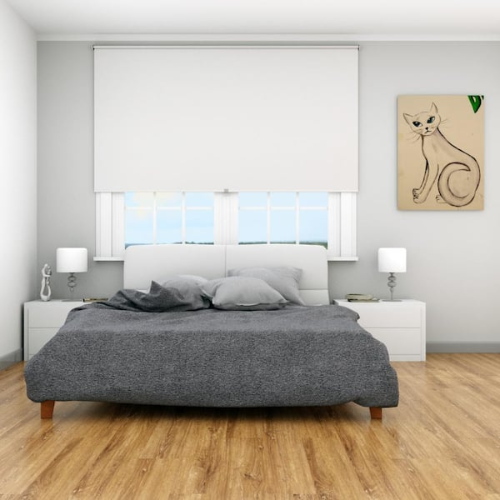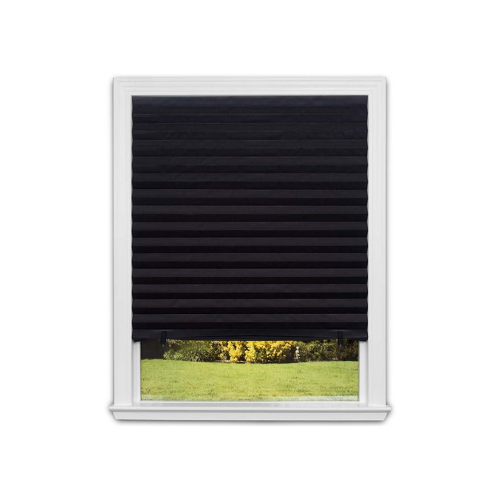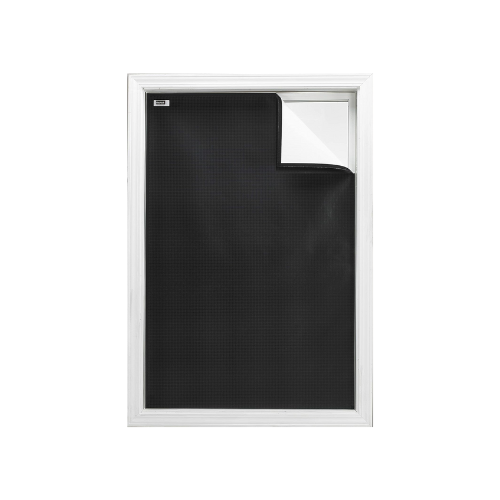The Best Blackout Shades, According to Sleep Doctors, Consultants, and Coaches

Our editors independently select the products we recommend. We may earn a commission on items bought through our links.
Everyone has late nights sometimes, and late nights can lead to late mornings. But anyone who’s ever slept late knows the sun doesn’t shy away from disrupting an adjusted sleep schedule. It screams through the window and demands everyone follow a certain timetable.
Today's Top Deals
By blocking external light, the best blackout shades keep the sun and its harsh white light behind the window, preserving the peace and hopefully a few more minutes of shut-eye before the alarm kicks in. Even people who never sleep late can benefit from blackout shades: Nothing’s worse than sitting down to watch some early evening TV when the sun is at just the right angle to cause the perfect glare. And, experts say a pitch-black room is better for achieving optimal amounts of REM sleep.
Though blackout shades can be installed by a professional contractor, they’re fairly straightforward to setup and don’t cost a fortune, making them an ideal candidate for zealous DIY-ers. Blackout shades run anywhere between $25 and $100, depending on the size of the window and the type and number of shades. They can be engineered to fit most standard window sizes and purchased in bulk so every shade in the bedroom matches.
What the Experts Say
SPY spoke with three sleep experts and two interior designers to better understand blackout shades, including Dr. Shelby Harris, director of sleep health at Sleepopolis; Julia Siemen, a certified sleep science coach at Sleep Advisor; Kelly Murray, a sleep consultant; Anita Yokota, interior designer, licensed therapist and author of “Home Therapy”; and interior designer Stephanie Purzycki, the CEO, creative director and founder at The Finish.
Blackout shades are typically cord-driven, up-down fabric shades — in contrast to drawn curtains or blinds with slats — designed with thick materials meant to block sunlight. Other shades promise room-darkening or light-filtering, but true blackout shades are intended to let no light pass through the fabric “through the use of dense, light-blocking materials, tightly woven fabrics, and proper installation at the windows to eliminate gaps where light could shine through,” Harris says. The end result, Yokota says, is a darker room better for healthy sleep. “By fostering a conducive sleep environment, blackout shades contribute significantly to regulating the sleep-wake cycle, promoting the restorative sleep necessary for overall well-being.”
While most people don’t need that level of light-blocking, Murray says blackout shades can be practical for night shift workers, kids’ rooms, migraine sufferers, and troubled sleepers. Harris agrees, “Blackout shades are a fantastic solution for people who struggle with sleep because they block out all the outside light, helping signal to the body that it’s time to sleep and promote the production of melatonin, a hormone crucial for regulating the sleep-wake cycle.”
If style is no object and money is, the most popular blackout shades are cellular, aka honeycomb, shades, roller shades, and pleated shades, with many styles in between. “Cellular shades are great at blocking light, but they don’t look that great,” Purzycki says, preferring inset Roman shades. Roller shades are great for large windows and more common in offices and hotels, but Harris says blackout roller shades can also work well if they’re thick enough and sized correctly. Cellular shades have the bonus of thermal insulation due to air contained in the honeycombs, which prevents heat transfer.
Some shades are stylish and others are practical, but all blackout shades have one downside, albeit a fixable one: Whether mounted inside or outside the window frame, light has a way of peeking around the edges, creating the so-called halo effect, Yokota says. Multiple experts say blackout curtains can help close the gap, hanging around the shade to get those sneaky bits of light, as well as work as a standalone light-blocking solution with large enough curtains.
Ultimately, as long as potential buyers do a little diligence (and measure before buying), they’ll likely end up with a good, functional fit and a big decrease in light levels. Here are the best brands available, backed by our experts.

BEST OVERALL
TRIPPEVALS Black-out Cellular Blind (White)
Buy Now
When it comes to all-around quality home blackout shades, Ikea leads the way with its Trippevals Black-out Cellular Blind. Offered in a selection of eight widths that match most windows, these shades take a lot of thought out of the process: Just measure the window, pick the closest width for a successful mount, buy, and get to work.
“These blinds are energy-efficient, helping to keep your room cool in summer and warm in winter,” Siemen says. “The white color also reflects sunlight, which is an added plus.”
In one of the best developments to most modern shades, the cord is inside the shades.
Overall, this will take a little work like every shade installation and it comes with everything needed to mount except screws, but once it’s mounted, the Trippevals delivers on its simple promise to block as much external light as it can and for a pretty reasonable price around $67.

BEST ROLLER SHADES
iFit White Cordless Blackout Polyester Roller Shade
Buy Now
Anything that won’t be covered by Ikea will be covered easily by the iFit Cut-to-Width Cordless Blackout Roller Shade. With widths ranging from 24 inches to 73 inches down to half an inch, these cordless blackout shades use a standard coated polyester fabric to bounce light away and will likely be cheaper overall for larger windows.
“These shades combine a modern, cordless design with durable polyester fabric for some effective light-blocking,” Siemen says, noting the increased importance of getting accurate measurements for optimal fit and light-blocking.
These shades also come pre-mounted on their headrail and include all necessary mounting hardware to further simplify the installation process. Don’t forget to add a few extra inches if choosing to mount outside the window frame, which goes for all shades.

BUDGET SHADES
Redi Shade Original Blackout Pleated Paper Shade (6-Pack)
Buy Now On Amazon
The Redi Shade is one of the easiest-to-install blackout shades on the market. It comes in two widths, 36 inches and 48 inches, but they can be cut to any width and then stuck to the ceiling of the window frame for practically instant dropdown shades.
“This option scores brownie points for its user-friendly installation without requiring extra tools, which is convenient,” Siemen says. However, there are cons to such a simple, cheap design. “It’s important to note that the paper construction, while simple, might not match the durability of other fabric alternatives,” she adds. “The pleated design can also be a turn-off to some buyers (purely for aesthetics).”
For around $27, this shade could be terrible, but it blocks a lot of light for its style and price and is installable by anyone in any window. Also, it’s a six-pack at that price. That’s painful to argue with.

FOR TOTAL BLACKOUT
Blackout EZ – Total Sunlight Blocking Window Cover
Buy Now On Amazon
The Blackout EZ Window Cover is not a stereotypical shade but liberated from the confines of tradition, it offers a total blackout by sticking to the whole window. That means no halo effect and no light at all. Because it’s as easily removed as it is applied, it’s a perfect interim solution for people looking for more sophisticated shades or a permanent one for people who want easily removable absolute darkness.
“My favorite blackout shades are window covers, as they block out 100% of the light because they cover the entire window,” Murray says. “Blackout EZ [covers] are affordable, effective, and easy to install. I have had the same covers on my son’s room for five years and take them on and off each day. I am amazed that they still work as well as they did the first day we installed them.”
Plus, at around $50 for the 36-inch by 48-inch version, these covers cost about as much as or less than most traditional blackout shades, making them a bit more economical, as long as they fit the window type.
Frequently Asked Questions About Blackout Shades
What Do Blackout Shades Do? Why Should I Buy Them?
The best blackout shades mount on or in a window to block out external light. “These shades work by effectively blocking external light sources, such as street lights or sunlight, which can interfere with the natural sleep-wake cycle,” Murray explains. “Exposure to light, especially during nighttime, can suppress the production of melatonin, a hormone that regulates sleep. By eliminating external light, blackout shades support the body’s natural circadian rhythm and promote better sleep quality.”
In a sentence, blackout shades help create a dark space perfect for sleeping. That can be a big help to light sleepers easily disturbed by light, kids bedding down while the sun’s still out, or anyone who needs to sleep during the day.
Can Blackout Shades Help With the Halo Effect?
The halo effect is the circle of light that typically appears around shades with windows as a result of light slipping through the edges.
Blackout shades can’t get 100% around the halo effect, so blackout curtains, which can cover the sides of the window frame, are more suitable to handle it. Purzycki recommends using a French rod, which causes the curtain to turn and end at the wall, blocking the most light.
How Should I Choose the Best Blackout Shades for My Windows?
The most important thing to do is accurately measure the window to be covered. With precise measurements in hand, almost any shade sold as “blackout” will suffice.
But for people who only want less light, they need to determine how much darkness they want first, whether just a little bit with light-filtering shades or maximum dark with blackout shades. The labels aren’t meaningless, either: Only shades sold as “blackout” shades will block all light (minus the halo effect).
For people looking for stylistic flare as well as light-blocking, they will be best served by an interior designer who can consult on aesthetic as well as functional questions. For one idea, Purzycki suggests finding a beautiful fabric and light-blocking liner to be made into a blackout shade.
Besides Sleep, What Else Are Blackout Shades Good For?
In an increasingly screen-driven world, screen glare can be frustrating to anyone looking to relax with a movie or focus on work. The best blackout shades properly sized and installed block the overwhelming majority of light coming through the window, eliminating any chance of glare.
Proceed to Check Out
More Top Deals from SPY
Best of SPY